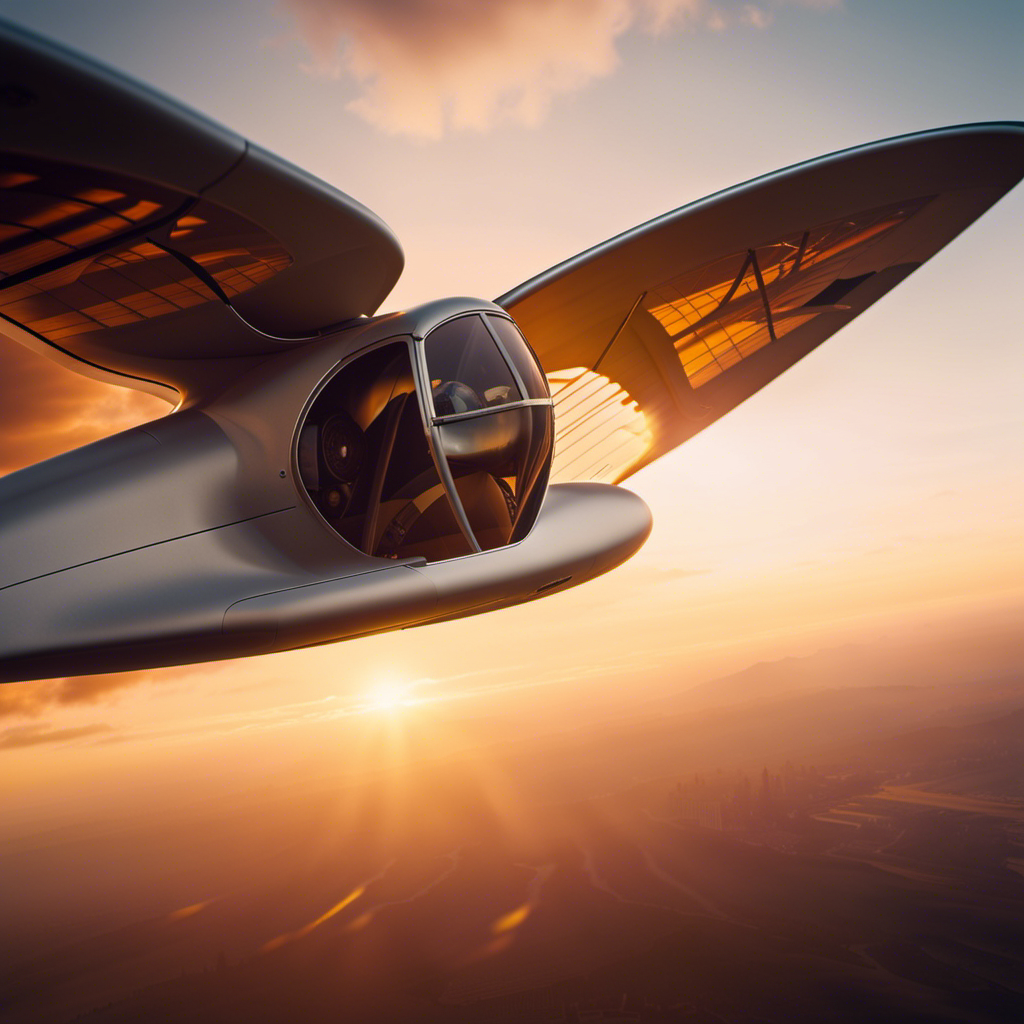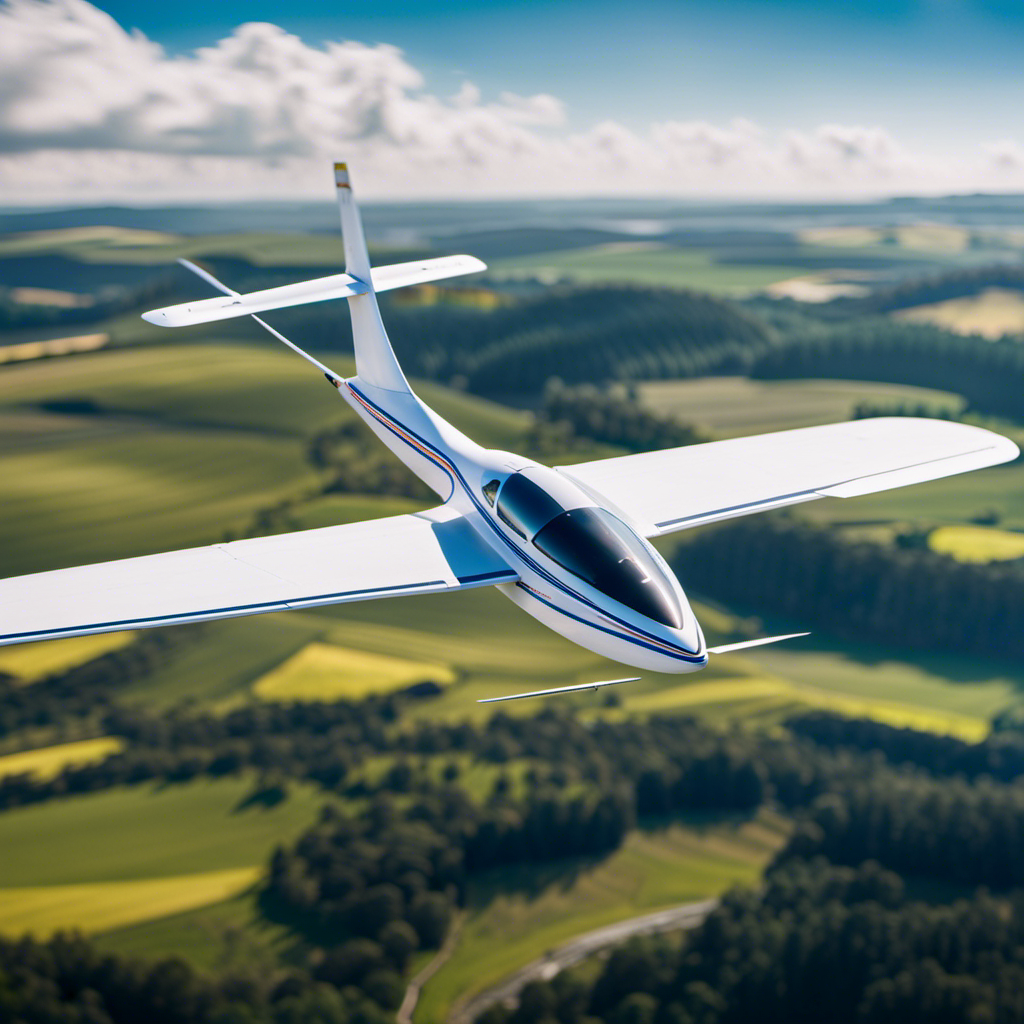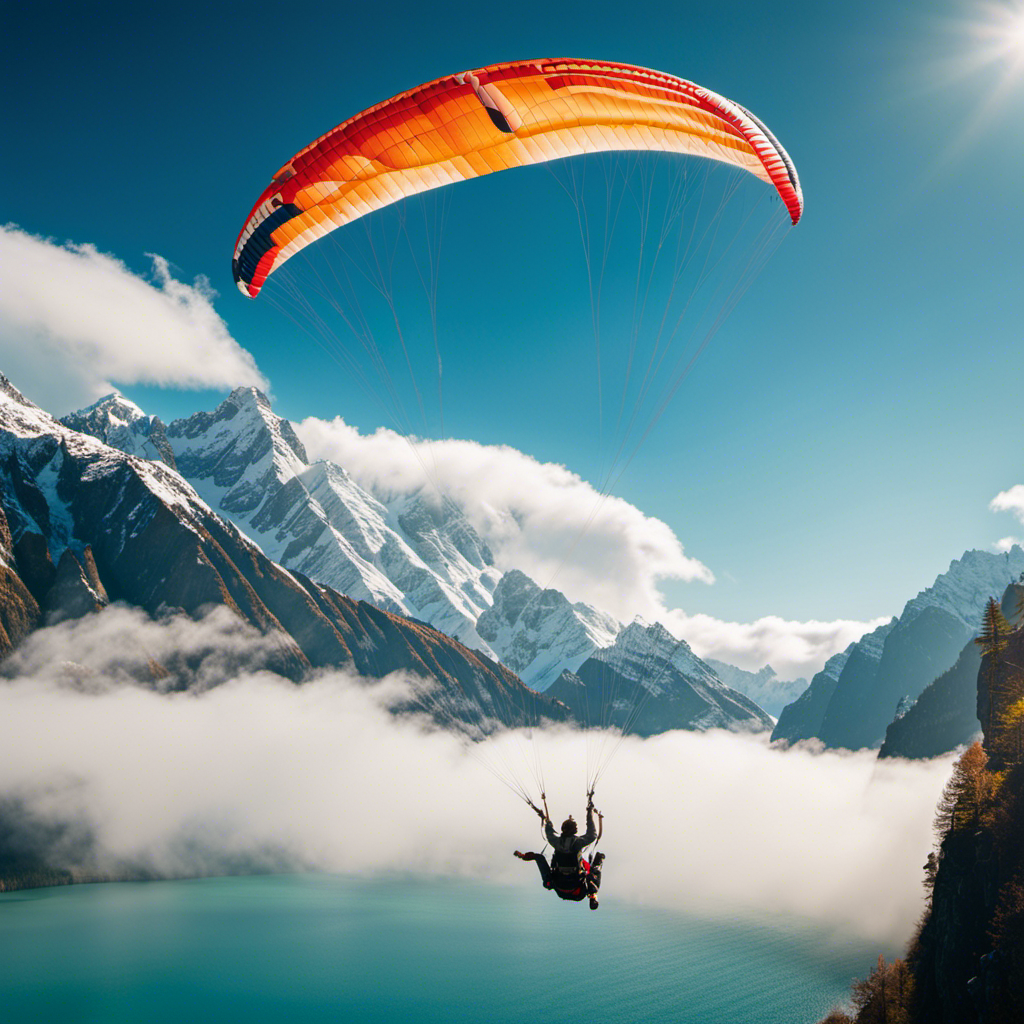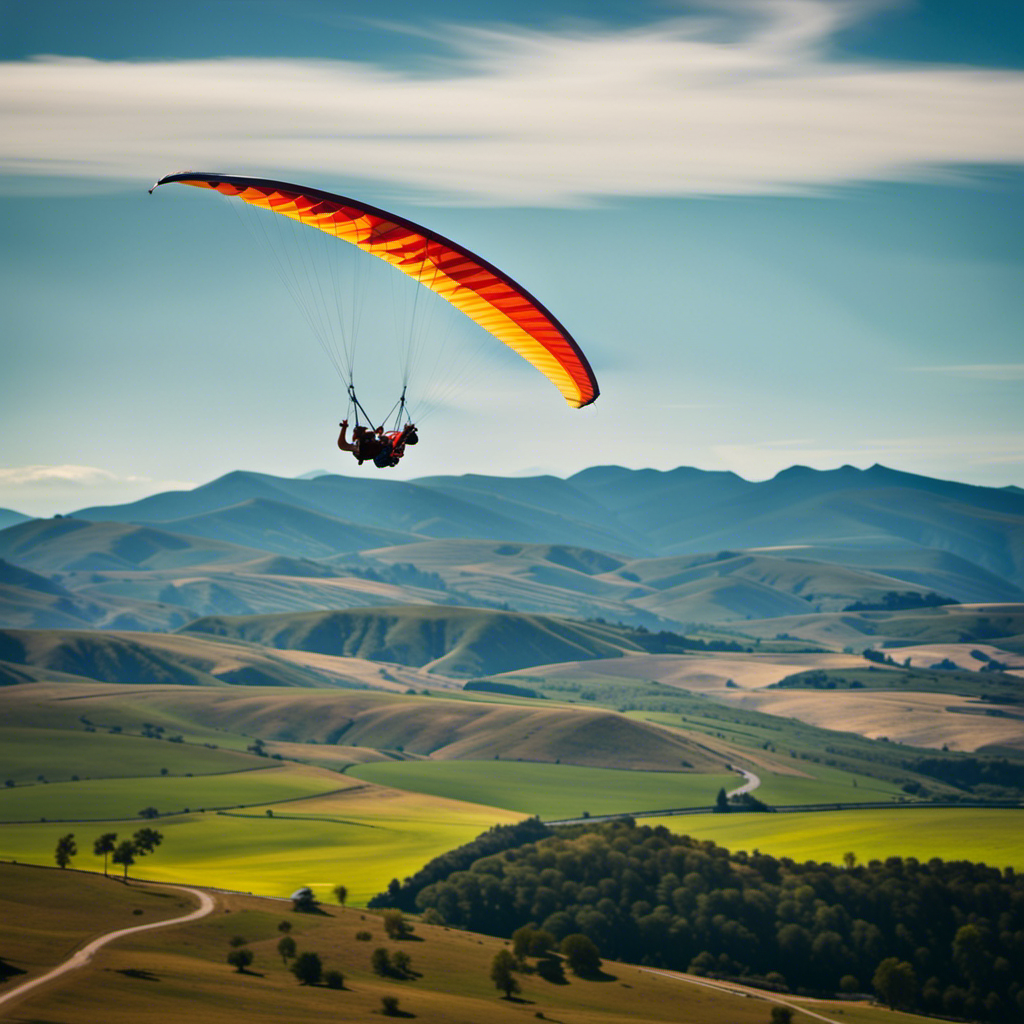Have you ever been awestruck by the effortless flight of a glider as it moves through the sky with elegance and precision? Picture being in the cockpit, experiencing the thrill of the wind on your face while you steer through the atmosphere.
Gliders are truly spectacular machines, combining aerodynamic design, speed, and more to achieve breathtaking performances. In this article, we will delve into the intricate world of gliders, exploring the factors that make them truly remarkable.
Get ready to embark on a thrilling journey into the world of gliding.
Key Takeaways
- Aerodynamic design plays a crucial role in the performance of a glider, including the shape of the wings, tail, and fuselage.
- Gliders with smooth, streamlined surfaces and wings shaped for optimal lift at different speeds and angles tend to have better performance.
- The weight and wingspan of a glider are important factors that can affect its performance.
- Understanding thermals and utilizing them effectively can significantly impact the flight time of a glider.
Aerodynamic Design
The aerodynamic design of a glider affects its performance in the air. When it comes to gliding, every little detail matters.
The shape of the wings, the angle of the tail, and even the curvature of the fuselage all play a crucial role in determining how well the glider can stay aloft and maneuver through the air.
A well-designed glider will have smooth, streamlined surfaces that minimize drag and maximize lift. The wings will be shaped to generate the right amount of lift at different speeds and angles of attack.
By carefully considering the aerodynamics, designers can create a glider that is efficient, stable, and responsive.
Now, let’s delve into the next section and explore the impact of speed and performance on gliders.
Speed and Performance
To achieve high speeds in gliding, you must master efficient techniques that make the most of aerodynamic forces.
Factors such as weight and wingspan play a crucial role in determining a glider’s performance.
Achieving high speeds through efficient gliding techniques
Achieving high speeds in a glider requires mastering efficient gliding techniques. To help you understand the key techniques involved, let’s explore a table that outlines three important techniques and their benefits:
| Technique | Description | Benefit |
|---|---|---|
| 1. Thermaling | Utilizing rising currents of warm air to gain altitude | Increases potential distance and duration of the flight |
| 2. Ridge Soaring | Flying close to the windward side of a ridge or hill | Allows for extended flights by utilizing the updrafts created by the wind |
| 3. Speed-to-Fly | Adjusting the glider’s airspeed to optimize performance | Maximizes the glider’s efficiency and speed |
Factors that affect glider performance, such as weight and wingspan
By considering factors like weight and wingspan, you can greatly impact your glider’s performance. The weight of the glider plays a crucial role in determining its ability to stay aloft and maneuver effectively. A lighter glider will have a higher glide ratio, allowing it to cover more distance with each unit of altitude lost.
Additionally, a longer wingspan increases the glider’s lift and reduces drag, resulting in improved performance. With these factors in mind, you can design a glider that maximizes its potential for soaring through the air.
Now, let’s delve into the world of record-breaking glider speeds and achievements, where skilled pilots have pushed the boundaries of what is possible in gliding.
Record-breaking glider speeds and achievements
Experiencing the thrill of soaring at record-breaking speeds in a glider can be an unforgettable achievement. Gliders have been known to reach incredible velocities, thanks to their sleek designs and efficient aerodynamics. These achievements are not just a result of pure luck, but rather a combination of meticulous engineering and skillful piloting.
Engineers strive to reduce drag and optimize lift, allowing gliders to achieve greater speeds with minimal effort. Pilots, on the other hand, rely on their expertise to navigate the skies and make strategic decisions that maximize their glider’s potential.
As gliders break speed records, they push the boundaries of what is possible in human flight. These accomplishments pave the way for further advancements in glider technology and inspire future pilots to reach new heights.
Soaring at record-breaking speeds is just one aspect of the incredible world of gliders; another essential component is understanding how thermals play a significant role in their flight.
Soaring and Thermals
When it comes to soaring and utilizing thermals for lift, understanding the concept is key. By grasping the mechanics of how thermals work and how gliders can harness their power, you can maximize your flight time and distance.
Techniques for finding and utilizing thermals during a flight require a combination of skill, experience, and observation, as you must constantly scan the sky for signs of rising air and adjust your flight path accordingly.
Lastly, meteorological conditions play a crucial role in successful soaring, as factors such as temperature, wind patterns, and cloud formations can greatly impact the availability and strength of thermals.
Understanding the concept of soaring and utilizing thermals for lift
Understanding how gliders utilize thermals for lift is key to comprehending the concept of soaring.
Thermals are pockets of warm air that rise from the ground due to temperature differences.
Gliders use thermals to gain altitude by circling within them.
The glider pilot must carefully analyze and exploit the thermals to stay aloft for extended periods.
Thermals provide a vital source of lift for gliders, allowing them to sustain their flights and reach higher altitudes. By harnessing these rising columns of warm air, gliders can conserve energy and increase their flight duration.
The pilot must possess a deep understanding of thermal dynamics and skillfully maneuver the glider within the thermal to maximize lift and climb rates. By knowing how to detect, enter, and exit thermals efficiently, the pilot can effectively navigate the sky and maintain altitude.
Mastering the techniques for finding and utilizing thermals during a flight is essential for successful soaring adventures.
Techniques for finding and utilizing thermals during a flight
To effectively find and utilize thermals during your flight, you’ll need to employ various techniques and strategies. Thermals are columns of rising air that can provide lift for your glider. By understanding how to locate and utilize these thermals, you can maximize your flight time and distance. Here are some techniques to consider:
| Technique | Description |
|---|---|
| Cloud Streets | Look for long, narrow bands of cumulus clouds that indicate thermals. |
| Wind Indicators | Pay attention to wind direction and speed to help locate thermals. |
| Terrain Features | Certain land formations can create thermals, such as ridges or slopes. |
| Circling Technique | Once you’ve found a thermal, use the circling technique to gain height. |
| Observing Other Pilots | Watch experienced pilots and learn from their flight patterns. |
Importance of meteorological conditions for successful soaring
Mastering the techniques for finding and utilizing thermals in conjunction with knowledge of meteorological conditions is essential for successful soaring. As a glider pilot, you must have a deep understanding of how weather patterns influence the formation and behavior of thermals.
Careful analysis of meteorological data, such as wind speed, temperature, humidity, and cloud formations, will allow you to identify areas where thermals are most likely to form. By observing the formation and movement of cumulus clouds, you can anticipate the location and strength of thermals. Additionally, understanding the stability of the atmosphere and the presence of any inversions or frontal systems will help you navigate and exploit thermals effectively.
With this knowledge, you can maximize your flight time and reach higher altitudes, increasing your chances of a successful and exhilarating soaring experience.
Now, let’s delve into the crucial safety features that must be considered in glider design.
Safety Features
You should always prioritize safety when it comes to designing and flying a glider, and that’s why incorporating reliable safety features is crucial. One of the most important safety features in a glider is the parachute system. This system allows the pilot to safely descend in case of an emergency.
Another essential safety feature is the cockpit design. It should be able to withstand high impact forces and protect the pilot in the event of a crash. Additionally, gliders are equipped with advanced avionics systems that provide real-time data on weather conditions and other flight parameters. These systems help the pilot make informed decisions and avoid potential hazards.
By prioritizing safety features in the design and operation of a glider, you can ensure a safer and more enjoyable flying experience.
Transitioning into the next section about ‘pilot skill and training,’ it is important to note that even with the best safety features, a glider is only as good as the person flying it.
Pilot Skill and Training
Transition: Now that you understand the important safety features of a glider, let’s delve into the crucial role of pilot skill and training in making a glider truly spectacular.
Pilot skill and training are essential factors that contribute to the overall performance and success of a glider. Here are three key aspects to consider:
-
Precise control: A skilled pilot possesses the ability to maneuver the glider with precision, making smooth and calculated turns, climbs, and descents.
-
Effective decision-making: A well-trained pilot can assess changing weather conditions, air traffic, and other variables, making quick and informed decisions to ensure the safety and efficiency of the flight.
-
Adaptability: A competent pilot can adapt to different flying conditions and handle unexpected situations, such as turbulence or wind shear, with confidence and composure.
By mastering these skills, pilots can maximize the potential of a glider, achieving exceptional performance and safety.
Now, let’s explore the world of glider competitions and events, where these skills are put to the ultimate test.
Glider Competitions and Events
Competing in glider competitions and events is an exhilarating experience that showcases your skills and expertise as a pilot. These events are not only a test of your abilities, but also an opportunity to demonstrate your understanding of glider aerodynamics and performance.
The precision required to navigate the designated course, exploit thermals, and maximize speed is paramount. As you glide through the air, you must make split-second decisions, constantly analyzing the changing conditions and adjusting your flight strategy accordingly.
The competitive atmosphere pushes you to push your glider to its limits, striving for the fastest time or the longest distance. These events serve as a platform to exchange knowledge and techniques with fellow pilots, fostering a culture of continuous improvement.
Now, let’s delve into the fascinating history and evolution of gliders.
Glider History and Evolution
When exploring the history and evolution of gliders, it is important to understand the early pioneers of glider flight. Otto Lilienthal and the Wright brothers laid the foundation for this field. Major milestones in glider technology and design have greatly improved the performance and safety of gliders. The development of aerodynamic control surfaces and the use of lightweight materials are examples of these milestones.
Moreover, the influence of glider development on the aviation industry cannot be overstated. Many principles and innovations in glider design have been adapted and applied to powered aircraft. This revolutionized the field of aviation as a whole.
Early pioneers of glider flight
The Wright brothers were among the early pioneers of glider flight. They were driven by a passion for aviation and a desire to push the boundaries of what was possible in the skies. Here are three key contributions they made to the field:
-
Innovative wing design: The Wright brothers developed a unique wing shape, known as the cambered airfoil, which provided greater lift and stability. This design became the foundation for modern gliders.
-
Control systems: They introduced a three-axis control system, consisting of the elevator, ailerons, and rudder. This allowed pilots to have precise control over the glider’s movements, making it easier to maneuver and maintain stability.
-
Wind tunnel testing: The Wright brothers were pioneers in using wind tunnels to test their designs before taking them to the skies. This allowed them to gather valuable data and make informed decisions about the optimal design and performance of their gliders.
These advancements laid the groundwork for major milestones in glider technology and design, which we will explore in the next section.
Major milestones in glider technology and design
One of the most significant advancements in glider technology was the introduction of a retractable landing gear. This innovation revolutionized glider design by allowing for improved aerodynamics and reducing drag during flight. The retractable landing gear enabled gliders to achieve higher speeds and greater maneuverability, enhancing the overall performance and efficiency of these aircraft.
The ability to retract the landing gear also made it easier to launch and land gliders, as the wheels could be safely stowed away during takeoff and landing. This advancement paved the way for further developments in glider technology, leading to the creation of sleeker and more efficient designs.
The influence of glider development on the aviation industry cannot be underestimated, as it set the stage for the evolution of modern aircraft and inspired advancements in both military and civilian aviation.
Influence of glider development on aviation industry
The introduction of retractable landing gear has greatly influenced the aviation industry, revolutionizing glider design and paving the way for advancements in modern aircraft. With the ability to retract the landing gear during flight, gliders have become more streamlined and efficient. This innovation has allowed gliders to achieve higher speeds and better maneuverability, enhancing their overall performance.
Additionally, retractable landing gear has also improved safety by reducing the risk of damage during landing and takeoff. As a result of this development, glider manufacturers have been able to create a wide range of glider types and variations, each tailored to specific needs and preferences. These variations include single-seat gliders for solo flying, two-seat gliders for training purposes, and high-performance gliders for competitive racing.
Glider Types and Variations
You can find various glider types and variations that make them spectacular. From the classic high-wing monoplane design to the sleek and modern composite materials, gliders come in all shapes and sizes. Each type has its own unique characteristics, such as the ability to soar effortlessly or reach high speeds.
The design of the glider plays a crucial role in its performance, with factors like wing shape, aspect ratio, and control surfaces affecting its aerodynamic efficiency. Additionally, advancements in technology have led to the development of high-performance gliders that can achieve impressive speeds and glide ratios.
These variations in design and performance contribute to the excitement and thrill of gliding, making it an exhilarating experience for aviation enthusiasts and pilots alike.
Moving on to gliding schools and experiences, you can explore the world of gliding and learn how to fly these magnificent aircraft.
Gliding Schools and Experiences
Experience the thrill of gliding at various schools that offer training and opportunities to fly these magnificent aircraft. Embark on an exhilarating journey as you learn the art of glider flying and explore the skies with grace and precision.
Here are three key features that make gliding schools and experiences truly remarkable:
-
Expert Instructors: Learn from experienced instructors who possess in-depth knowledge of glider dynamics and safety protocols. They will guide you through the process of mastering glider controls and teach you advanced techniques to navigate thermals and soar through the air.
-
State-of-the-Art Equipment: Gliding schools provide access to modern glider models equipped with cutting-edge technology. These aircraft are designed to optimize performance, ensuring a smooth and efficient gliding experience.
-
Scenic Locations: Immerse yourself in stunning landscapes as you glide through the air. Many gliding schools are situated in picturesque locations, offering breathtaking views and a truly memorable flying experience.
As you delve further into the world of gliding, the future of glider technology promises even more advancements and possibilities.
Future of Glider Technology
In the future of glider technology, you’ll explore the exciting advances in design and materials that are revolutionizing the industry.
From sleeker and more aerodynamic shapes to lightweight and durable materials, these advancements are pushing the boundaries of glider performance.
You’ll also delve into the potential for electric or hybrid-powered gliders, which offer the promise of reduced emissions and increased sustainability.
As gliders continue to play a role in sustainable aviation initiatives, their silent and energy-efficient nature make them a compelling option for the future of flight.
Advances in glider design and materials
Advances in glider design and materials have greatly improved their performance and efficiency. The use of modern materials, such as carbon fiber and composite materials, has allowed for lighter and stronger gliders. This reduction in weight has resulted in increased glide ratios and enhanced maneuverability.
Additionally, advancements in aerodynamic design have led to reduced drag and improved lift, resulting in increased speed and range. The incorporation of winglets and streamlined fuselages has further enhanced the gliders’ performance by minimizing turbulence and reducing air resistance.
These advancements have not only made gliders more efficient but have also improved their safety and stability. As a result, gliders can now reach higher altitudes, fly longer distances, and perform more complex maneuvers with precision.
With these advancements, the potential for electric or hybrid-powered gliders becomes even more promising. The improved performance and efficiency can be further enhanced by the use of sustainable power sources.
Potential for electric or hybrid-powered gliders
The potential for electric or hybrid-powered gliders is further enhanced by their improved performance and efficiency. This can be amplified by the use of sustainable power sources. Electric or hybrid-powered gliders have the advantage of being able to generate power without relying solely on traditional fuel sources. This allows for reduced emissions and a lower carbon footprint, making them more environmentally friendly compared to conventional gliders.
The electric or hybrid power systems can also provide increased power and longer flight times. This enables gliders to cover greater distances and explore new areas. In addition, the use of sustainable power sources such as solar or wind energy can further enhance the efficiency and sustainability of these gliders.
With these advancements, electric or hybrid-powered gliders are playing a significant role in sustainable aviation initiatives.
Role of gliders in sustainable aviation initiatives
You can contribute to sustainable aviation initiatives by recognizing the important role that gliders play in reducing emissions and promoting environmentally friendly flight. Gliders are a type of aircraft that rely solely on natural forces, such as wind and thermal currents, to stay aloft. They do not have an engine and therefore produce zero emissions during flight. By utilizing these natural forces, gliders are able to fly quietly and efficiently, making them an ideal choice for sustainable aviation. Not only do gliders help reduce carbon emissions, but they also provide a unique and thrilling flying experience. Their sleek design and ability to soar silently through the skies make gliders a truly spectacular aircraft.
| Design | Speed | Environmental Impact |
|---|---|---|
| Sleek and aerodynamic | Relatively slow compared to powered aircraft | Zero emissions during flight |
| Lightweight construction | Can reach high speeds in the right conditions | Low noise pollution |
| Efficient use of natural forces | Dependent on weather conditions | Minimal ecological impact |
Next time you look up and see a glider gracefully gliding through the air, remember that it is not just a beautiful sight, but also a symbol of sustainable aviation. By supporting and promoting glider flight, you are contributing to a greener and more environmentally friendly future in aviation.
Conclusion
In conclusion, the world of gliding is a captivating one. It encompasses a multitude of factors that contribute to the spectacular nature of these aircraft. From their aerodynamic design and exceptional speed to the art of soaring and utilizing thermals, gliders offer a unique flying experience.
Safety features and pilot skill play crucial roles in ensuring a successful flight. Pilots must be well-trained and knowledgeable about glider operations. Additionally, gliders are equipped with various safety features, such as parachutes and emergency systems, to ensure the well-being of the pilot.
The rich history and evolution of gliders add depth to this fascinating sport. Gliding has been around for over a century, and throughout the years, gliders have undergone significant advancements in design and technology. There are various types and variations of gliders, each with its own unique characteristics and capabilities.
Interestingly, statistics reveal that gliders have an impressive glide ratio of up to 60:1. This showcases their remarkable efficiency in maintaining altitude and covering long distances. Gliders can glide for extended periods, utilizing rising air currents and thermals to stay aloft.
As technology continues to advance, the future of glider technology looks promising. Innovations in materials, propulsion systems, and avionics will likely enhance the performance and capabilities of gliders even further. This promises even more awe-inspiring experiences in the skies for glider enthusiasts.
With a heart that soars as high as the skies, Aria, affectionately known as “Skylark,” is the driving force behind Soaring Skyways. Her journey into the gliding world began as a young dreamer gazing up at the soaring birds, yearning to experience the weightlessness and freedom they embodied. With years of experience both in the cockpit and behind the scenes, Aria’s commitment to the gliding community is unwavering.










